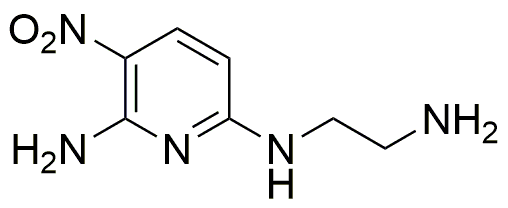2,6-Diamino-N2-(2-aminoethyl)-5-nitropyridine is widely utilized in research focused on:
- Pharmaceutical Development: This compound serves as a key intermediate in synthesizing various pharmaceuticals, particularly those targeting specific biological pathways, enhancing drug efficacy.
- Agricultural Chemicals: It is employed in the formulation of agrochemicals, providing effective solutions for pest control and plant growth regulation, contributing to sustainable agriculture practices.
- Biochemical Research: Researchers utilize this compound to study enzyme interactions and metabolic pathways, facilitating advancements in biochemistry and molecular biology.
- Material Science: Its unique properties make it suitable for developing advanced materials, including polymers and coatings, which offer improved durability and functionality.
- Analytical Chemistry: The compound is used in various analytical techniques, aiding in the detection and quantification of other substances in complex mixtures, thus enhancing research accuracy.
General Information
Properties
Safety and Regulations
Applications
2,6-Diamino-N2-(2-aminoethyl)-5-nitropyridine is widely utilized in research focused on:
- Pharmaceutical Development: This compound serves as a key intermediate in synthesizing various pharmaceuticals, particularly those targeting specific biological pathways, enhancing drug efficacy.
- Agricultural Chemicals: It is employed in the formulation of agrochemicals, providing effective solutions for pest control and plant growth regulation, contributing to sustainable agriculture practices.
- Biochemical Research: Researchers utilize this compound to study enzyme interactions and metabolic pathways, facilitating advancements in biochemistry and molecular biology.
- Material Science: Its unique properties make it suitable for developing advanced materials, including polymers and coatings, which offer improved durability and functionality.
- Analytical Chemistry: The compound is used in various analytical techniques, aiding in the detection and quantification of other substances in complex mixtures, thus enhancing research accuracy.
Documents
Safety Data Sheets (SDS)
The SDS provides comprehensive safety information on handling, storage, and disposal of the product.
Product Specification (PS)
The PS provides a comprehensive breakdown of the product’s properties, including chemical composition, physical state, purity, and storage requirements. It also details acceptable quality ranges and the product's intended applications.
Certificates of Analysis (COA)
Search for Certificates of Analysis (COA) by entering the products Lot Number. Lot and Batch Numbers can be found on a product’s label following the words ‘Lot’ or ‘Batch’.
*Catalog Number
*Lot Number
Certificates Of Origin (COO)
This COO confirms the country where the product was manufactured, and also details the materials and components used in it and whether it is derived from natural, synthetic, or other specific sources. This certificate may be required for customs, trade, and regulatory compliance.
*Catalog Number
*Lot Number
Safety Data Sheets (SDS)
The SDS provides comprehensive safety information on handling, storage, and disposal of the product.
DownloadProduct Specification (PS)
The PS provides a comprehensive breakdown of the product’s properties, including chemical composition, physical state, purity, and storage requirements. It also details acceptable quality ranges and the product's intended applications.
DownloadCertificates of Analysis (COA)
Search for Certificates of Analysis (COA) by entering the products Lot Number. Lot and Batch Numbers can be found on a product’s label following the words ‘Lot’ or ‘Batch’.
*Catalog Number
*Lot Number
Certificates Of Origin (COO)
This COO confirms the country where the product was manufactured, and also details the materials and components used in it and whether it is derived from natural, synthetic, or other specific sources. This certificate may be required for customs, trade, and regulatory compliance.

